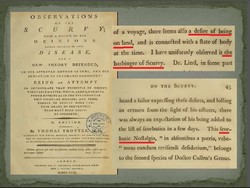| Thomas Trotter, who had called it (the depression) “Scorbutic Nostalgia”, observed it to be “the harbinger of Scurvy” and described it as “a desire of being on land” (24). Instinctively the sick person longed to be where the cure for his illness could be found. The most intriguing aspect of Vesalius’ altered behaviour was his fear of being buried at sea. It is as if his desire to be on land was so strong that he could not bear the thought of being away from it forever.
The second mentioned symptom is Vesalius’ collapse and instant death. The sudden death of scorbutic patients, often while they felt well enough to engage in some activity and while doing their utmost, has been observed and documented in several medical treatises and in accounts of long sea voyages (25). So many died after stepping out of the hold and onto the deck, or during and immediately after their disembarkation, that it was believed the change of air could kill a man with scurvy (26). This is exactly how Vesalius’ death is described: he dropped dead, soon after landing and while striving to complete the short walk to the first buildings of Zakynthos.
Article continued here: Powerful indications that Vesalius died from scurvy (4)
Initial page of this article here.
Sources and author's comments:
14. 6% of the plant species in use, according to Raeda Tawfeeq Ebrahim Daoud in Studies on Folkloric Medicinal Plants Used by Palestinians in the Qalqilia District, An-Najah National University, Nablus 2008, p. 32, table 3.3.
15. Assistance to Palestine Refugees, Report of the Director of the United Nations Relief and Works Agency for Palestine Refugees in the Near East, General Assembly, Official Records: Sixth Session, Supplement No 16 (A/1905), 28 September 1951, Chapter 1, 31.
16. Voyages and Travels in the Levant in the Years 1749, 50, 51, 52, London 1766, p. 147.
17. Olaf Mickelsen and Ancel Keys, The composition of sweat, with special reference to the vitamins, The Journal of Biological Chemistry, 1943, pp. 479 - 490.
18. Adam Melchior, Vitae Germanorum medicorum, Frankfurt Main 1620, p. 133. Also in a manuscript, with the title De morte Vesalii ex letteris Huberti Langueti, scriptis ad D. D. Casparu[m] Peuceru[m], National Library of Medicine, Bethesda, Washington DC (manuscript E 86).
19. According to Felix Faber, who travelled to the Holy Land in the last quarter of the 15th century, food on a pilgrim galley consisted of bread or biscuit, panada, cheese, eggs and mutton or fish; also lettuce with olive oil when they could find it. See Fratris Felicis Fabri Evagatorium in Terrae Sanctae, vol. 1, Stuttgart 1843, pp 136 – 137. In Vesalius’ time travelling in the Mediterranean in a sailing ship rather than a galley had become much more common. Those ships did not need frequent stops for water like the galleys, so fewer chances of lettuce salad. For his desert journey Faber used biscuit, smoked meat, smoked cheese, smoked fish, eggs, rice, almonds, oil, butter, vinegar, salt, wine, live poultry, raisins and onions. Information from the book Once to Sinai: The further pilgrimage of Friar Felix Fabri, by H.F.M. Prescott, New York 1958. Of these only onions contain appreciable quantities of Vitamin C when raw but hardly any if they are sautéed. For obvious reasons boiling was not very popular in the desert.
20. Deglet noor dates contain only 0.4 mg per 100 g. Medjool dates contain nil. Data from the United States Department of Agriculture
21. Robert A. Kinsman and James Hood, Some behavioral effects of ascorbic acid deficiency, The American Journal of Clinical Nutrition, April 1971.
22. Fiona E. Harrison, Behavioural and neurochemical effects of scurvy in gulo knockout mice, Journal for Maritime Research, Volume 15, Issue 1, 2013.
23. Report of a Committee of the Associate Medical Members of the Sanitary Commission on the Subject of Scurvy with Special Reference to Practice in the Army and Navy, Washington 1862, p. 17.
24. Observations on the Scurvy, 2nd Edition, London 1792, pp. 44 – 45.
25. For example Richard Walter, A voyage round the world in the years MDCCXL, I, II, III, IV, 5th edition, London 1749, p. 101 and James Lind, A Treatise on the Scurvy, London 1772, p. 132 and p. 281.
26. Thomas Trotter, Observations on the Scurvy, 2nd Edition, London 1792, p. 48.
|




